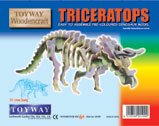Paper Mache Dinosaurs
On July 15th it was Saint Swithun’s day. Saint Swithun was an early English Bishop, his diocese was Winchester. Folklore says that whatever the weather on Saint Swithun’s day, over the next 40 days England will have the same weather. So if it is fine on July 15th expect it to be a decent Summer, however, if it is wet expect rain over the next 40 days.
Many farmers and country folk still use many of these traditional folklores to predict the weather, we have no records of how accurate this has proved in previous years, but since July 15th was wet I guess we can expect the miserable British summer to continue.
Paper Mache Dinosaurs
Rain can have a serious impact on fossil excavation sites, once whilst in the Dinosaur Provincial Park area of Alberta, Canada a sudden downpour made the mudstone strata we were working on extremely slippy. The whole site turned into an ice rink and it was dangerous just to try walking on the slopes, let alone trying some serious excavation work.
On rainy days it can be difficult to find things for young dinosaur fans to do. One exercise that we have done with our focus groups and various groups of school children is to make paper mache dinosaurs. We have a number of what we call “Table Top” activities and making a paper mache dinosaur is a fun way to spend a couple of wet afternoons.
To make the framework for the paper mache dinosaur we used some of our woodencraft kits, the wooden parts can be fitted together and this provides the idea skeleton framework for adding the paper mache “flesh”. These items are relatively cheap to purchase and there are eleven different animals in our series so there are lots and lots to choose from.
A Woodencraft Kit we use for the Paper Mache Framework

To see Woodencraft items and dinosaur toys click here: Everything Dinosaur.
Old Newspapers Required
You need plenty of old newspapers, we tend to tear ours up into strips of about two inches long, although for the smaller more delicate parts of the sculpture like the horns of the Triceratops we used tiny pieces of newspaper. Then using wallpaper paste we started to build up our dinosaurs using the Woodencraft skeleton to guide us. We discovered the trick was to dip the paper strips in the paste but then to squeeze them through your fingers to remove excess glue. This made the strips pliable but not too soggy.
When putting on the strips make sure that you smooth them out and remove any air bubbles, children with their little fingers are best at this. Once the first layer had been added we let the models dry thoroughly, best to leave them overnight if you can.
A second layer is added the following day, and then once this has dried the models can be painted and put on display.
Remember, good palaeontologists always tidy up after themselves, so part of the exercise is to tidy up afterwards. There have been a few messy palaeontological expeditions in the past but these days the object of a tidy up on a site is to make sure that area is returned to its natural state as much as possible – minus any dinosaurs that may have been removed of course.






Leave A Comment